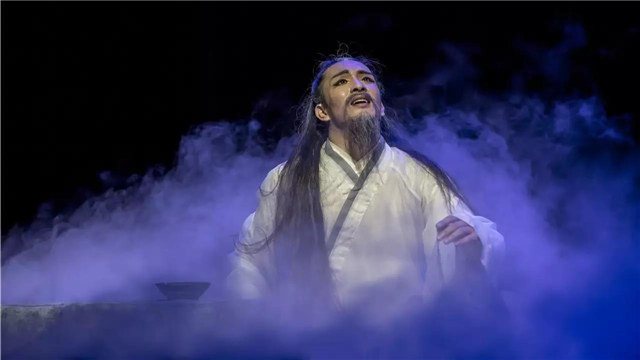Dance drama portrays poet's life
 0 Comment(s)
0 Comment(s) Print
Print E-mail chinadaily.com.cn, March 14, 2018
E-mail chinadaily.com.cn, March 14, 2018
In China, Tang poet Li Bai (701-762) is an indisputable household name. Generations of Chinese artists have created works paying tribute to this great figure in the history of Chinese poetry, and China National Opera & Dance Drama Theater has made the first attempt to portray the life of this romantic genius through dance, with a drama titled Li Bai.

On March 10 and 11, the dance drama was staged twice at the National Center for the Performing Arts in Beijing. Combining "the reality" and "the dream", the drama mainly unfolds two parts of Li's life – his miserable later years after the An Shi Rebellion (755-763) and the years of his life spent happily in the Hanlin Academy in Chang'an, the capital of the Tang Dynasty (618-907).
Starting with the poet's exile to Yelang (in present-day Guizhou province), a remote southwestern part of the empire, the drama is told in flashback. The whole drama, comprising five themes highlighting Li's life, tries to explore the poet's inner world when he was unsure whether to pursue an official career or to be a detached hermit.

Han Baoquan, the director of the drama, said he had long been mulling over the question "What extraordinary life experiences on earth did Li Bai have that made him an immortal poet?" and it was this question that led to the creation of this drama.
"I want to cast aside all the praise he enjoys and recreate a Li Bai who is flesh and blood. He is a man struggling between sense and sensibility, aspiring to be a standout in officialdom as well as entertaining the desire to retire from it. On the one hand, he is a nonconformist rapt with wine and poetry," Han said in an interview.
"On the other, he has to conform to what he disdains so as to realize his dream as a scholar. All in all, he has lived up to the reputation as a 'Poetic Genius', always romantic and optimistic."

The production team decided to use a rhythmic and poetic body language to present the drama after deeply delving into Li's poems. Xu Ning, choreographer of Li Bai, said "by fusing Chinese classical dance with modern aesthetics, we transformed his poems into dance, giving the drama a natural contemporary feel."
The stage was decorated in gold and black, a color match inspired by the architecture style in the "golden age" of the Tang Dynasty, Li's calligraphy and the landscape painting during the period of the Five Dynasties and Ten Kingdoms (907-960). The color combination is an ingenious pairing, with gold symbolizing the poet's worldly pursuits and black his poetry.
Two traditional Chinese instruments were featured heavily in the dance drama: gu qin, a seven-stringed zither and xiao, a vertical bamboo flute. The music played by gu qin stands for the shackles of society and the sound of xiao expresses the poet's wish to free himself from those shackles.






Go to Forum >>0 Comment(s)